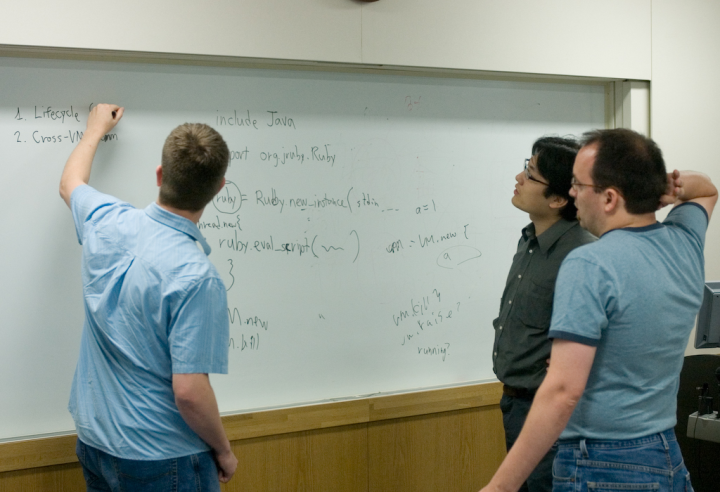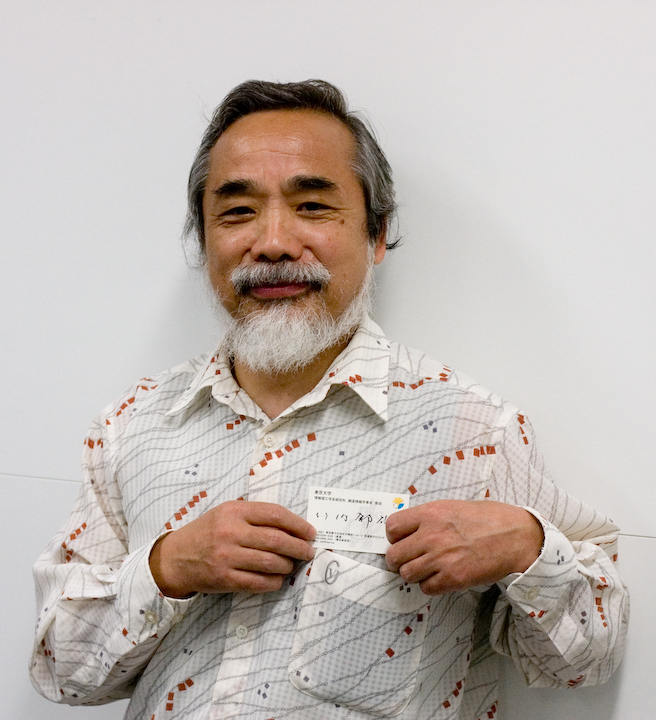
Last Monday, we spent some time at the University of Tokyo, where we talked about Ruby and so on; quite a change of pace from the rest of the visit.
We’re talking about maybe funding some joint R&D; here we have Nutter and Enebo, the JRuby guys, doing some white-boarding with Koichi Sasada, also known as “Ko1 the YARV guy”.
Also in that meeting was this charming older gentleman who asked how many of us were going to be getting business cards, pulled out a little pen-and-ink set, and hand-lettered his name into a space in the middle for each of us.
That’s a collector’s item, because he turned out to be Ikuo Takeuchi (竹内 郁雄), best known as the inventor of the Tak function. Definitely an unexpected pleasure.
We had lunch at a nice little on-campus restaurant, then I gave a lecture on what’s new and Web 2.0 and all that jazz. It was packed, and the questions were intelligent. I learned that they’ve started teaching first-year undergrads Ruby instead of Java, and that Prof. Ko1 is doing some of the teaching. Wish I’d learned programming that way. [My first taste was FORTRAN tought by a useless drug hippie.]
The campus is a nice green academic oasis; central Tokyo needs all the green calm it can get. Here’s the central building, which I gather symbolizes the University.
Outside the University’s Red Gate, facing yet another busy grey concrete Tokyo streetscape, is this:




Comment feed for ongoing:
From: Chris (Jun 22 2007, at 20:45)
Looks like a nice place to learn.
First programming experience, US public high school, 1976: DEC PDP-8 machine language. The computer had 4kbits of core memory, teletype with paper tape punch/reader. First actual hands-on assignment was to load your code and data (your name) via the front panel switches and have it print on the teletype. Spent weeks writing the code and desk-checking before being allowed to lay hands on the hardware. The pattern of the lamps flashing would let you know whether your program was likely to work or not (pseudo-random was better). I've been a sucker for visual feedback from systems ever since, it gave a very visceral indication of success.
cp
[link]
From: Tim (Jun 23 2007, at 06:12)
If this turns into a reminisce-fest: my first programming experience was on an EDP-16, a desk-sized computer with a teletype, and lighted buttons which also could switch values into memory. I don't know who made it, but for the first two weeks or so of the course we punched programs in octal directly into memory. As a result, I learned computers from the bottom up - machine language, assembler, higher-level language (was it BASIC?); I believe this education made it easier for me to learn all sorts of higher-level languages since to me they are all just convenient ways of getting the machine code in there.
[link]
From: John Cowan (Jun 23 2007, at 08:14)
The PDP-8 forever!
http://www.cs.uiowa.edu/~jones/pdp8/ has documentation original and modern, emulators written in C, FOCAL-1969 and OS/8, and everything the PDP-8-lover might want.
[link]
From: John Cowan (Jun 23 2007, at 22:49)
Looks like your URL-detecting logic has a bug.
[link]